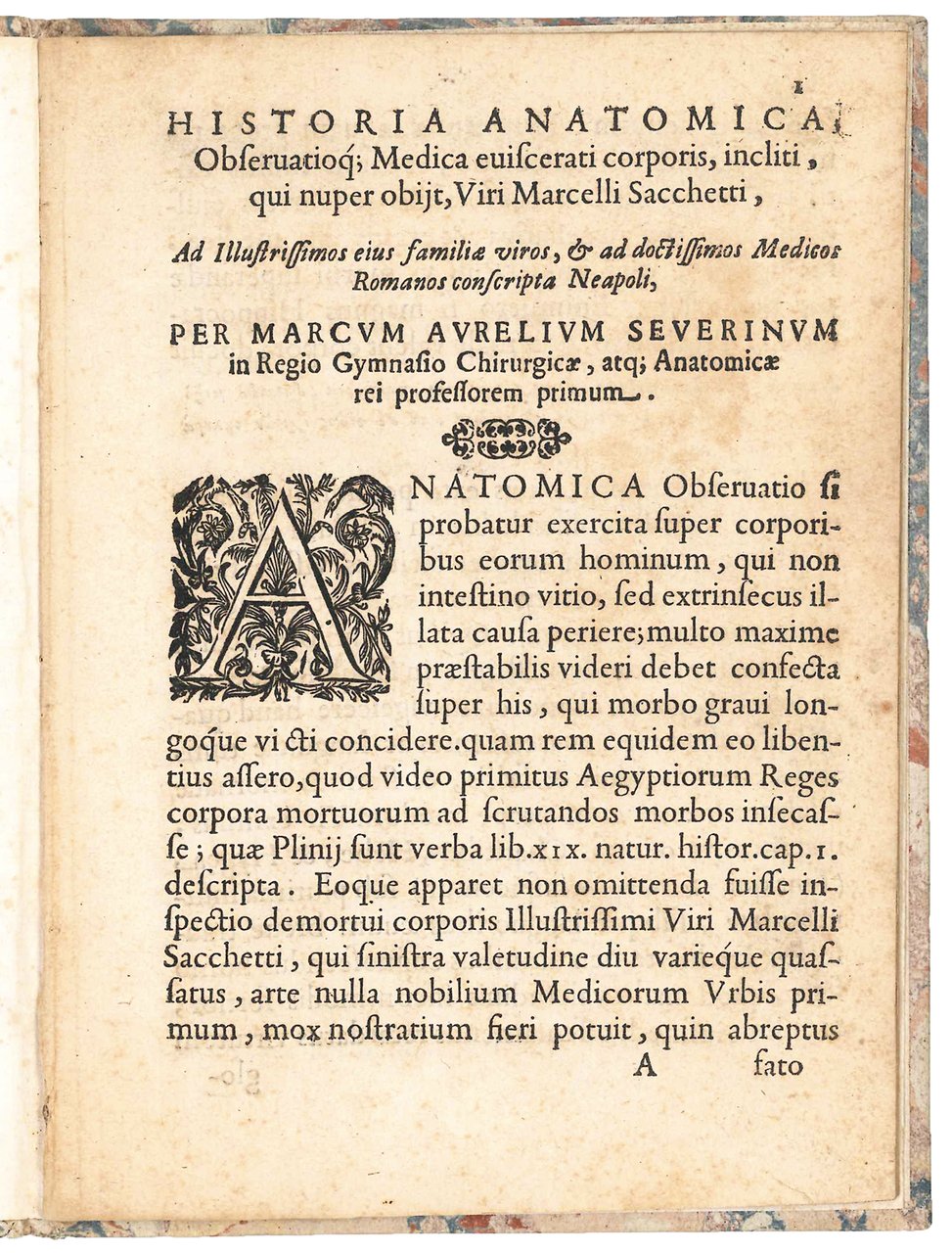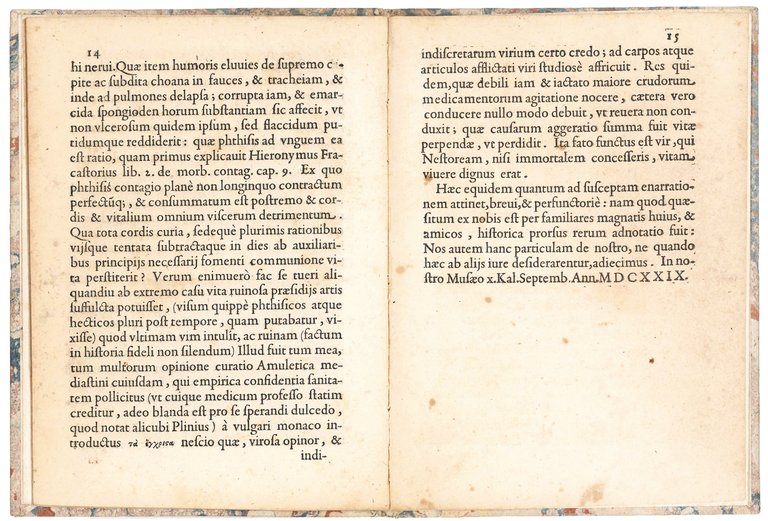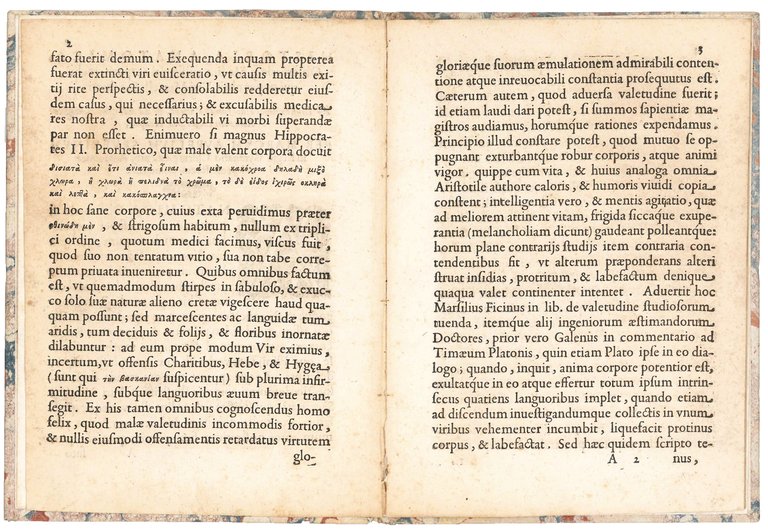


Libros antiguos y modernos
SEVERINO, Marco Aurelio (1580-1656)
Historia anatomica, Observatioque Medica eviscerati corporis, incliti, qui nuper obijt, Viri Marcelli Sacchetti, Ad Illustrissimos eius familiae viros, & ad doctissimos Medicos Romanos conscripta Neapoli, per Marcum Aurelium Severinum in Regio Gymnasio Chirurgicae, atque Anatomicae rei professorem primum. At the end: In nostro Musaeo x.Kal. Septemb.Ann.MDCXXIX
23 August 1629
2400,00 €
Govi Libreria Antiquaria
(Modena, Italia)
Los gastos de envío correctos se calculan una vez añadida la dirección de envío durante la creación del pedido. El vendedor puede elegir uno o varios métodos de envío: standard, express, economy o in store pick-up.
Condiciones de envío de la Librería:
Para los productos con un precio superior a 300 euros, es posible solicitar un plan de pago a plazos al Maremagnum. El pago puede efectuarse con Carta del Docente, Carta della cultura giovani e del merito, Administración Pública.
Los plazos de entrega se estiman en función de los plazos de envío de la librería y del transportista. En caso de retención aduanera, pueden producirse retrasos en la entrega. Los posibles gastos de aduana corren a cargo del destinatario.
Pulsa para saber másFormas de Pago
- PayPal
- Tarjeta de crédito
- Transferencia Bancaria
-
-
Descubre cómo utilizar
tu Carta del Docente -
Descubre cómo utilizar
tu Carta della cultura giovani e del merito
Detalles
Descripción
4to (192x139 mm). 15, [1 blank] pp. Collation: A4. Woodcut decorated initial. Modern marbled cardboards. Slighlty browned and foxed, but a good copy.
Apparently only copy known. In 1629 Severino was at the height of his fame as a surgeon and anatomist, despite not having published anything yet except a manual on practical surgery (Il barbiere, 1626, reprinted in 1629 under the title Nuova prattica della decoratoria manuale et della sagnia), which came out under the name of his assistant Tiberio Malfi.
On 23 August 1629, Severino was called upon to perform an autopsy on the body of Marcello Sacchetti, a powerful Roman merchant and secret treasurer of the Apostolic Chamber who also served the Barberini family as an art connoisseur. He had died in Naples a few days before. The text containing Severino's anatomical observations on Sacchetti's body was privately printed in Naples in 1629 and was later included in his main work, De recondita abscessuum natura (pp. 135-143); it also appears in the Severino manuscript (ms. 35 LXXIV.2.13) of the Lancisiana Library in Rome (ll. 70r-83v, 23 August 1629).
This edition, of which there is apparently no recorded copy in any library worldwide, was long believed to be lost, and even its existence was doubted. This is how C. B. Schmitt and C. Webster wrote in 1971: “Apparently De recondita abscessuum natura (Naples, 1632) was his first work to appear in print. Various secondary works, including Biographisches Lexikon V, 242; Capparoni II, 67; Tafuri, p. 22; Mercklin, p. 777; Portal, II, 494, list Historia anatomica observatioque medica eviscerati corporis (Neapoli, 1629). Biographisches Lexikon , V, 242 also gives a French translation of the work published by J. Vigier in 2 vols, at Paris in 1629. We have been unable to verify the existence of such editions and there does not seem to be a work of that title among the Severino mss. which we know. Moreover, the early lists of Severino's writings in Chocolata inda (1644), pp. 69-73 and in Therapeuta Neapolitanus (1653), fols. §§ 2r-§§ 4r do not mention a work of this or of a similar title. It is worth noting that the Fourth Part of Severino's Zootomia Democritea (1645), p. 286 f. has the title Historia anatomica varii generis animantium describitur, inconibusque certis plurima parte repraesentatur, and the supposed 1629 work might somehow have arisen from a confusion with this” (Harvey and M. A. Severino: A Neglected Medical Relationship, in: “Bulletin of the History of Medicine”, vol. 45, no. 1, January-February 1971, p. 53).
Marco Aurelio Severino was a pioneer of comparative anatomy who made major contributions to the advancement of oncology and was highly celebrated in his time.
Born at Tarsia in Calabria, he spent the most formative periods of his life in Naples, where he carried out his studies in medicine and began teaching, before obtaining first the chair of surgery and anatomy at the University, then the post of first surgeon at the Ospedale degli Incurabili. In Naples he met and began working with Tommaso Campanella (1568-1639), whom he regarded as a teacher and from whom he took a keen interest in the natural philosophy of Bernardino Telesio (1509-1588).
In addition to his influential research and practice in the fields of medicine, anatomy, and animal physiology – and despite threats to his career by the Inquisition, who objected to his allegedly unorthodox beliefs, and others who took issue with his supposedly ‘cruel' method of healing patients –, Severino forged important international connections with the European intellectual milieu. These relations are well documented by a rich correspondence with figures of international renown and reflect Severino's eminence and reputation. Among his distinguished correspondents – which include Cassiano dal Pozzo, who assisted Severino in finding skilled illustrators for scientific drawings; John Houghton, who fostered the support of Harvey's theories; and Johan

